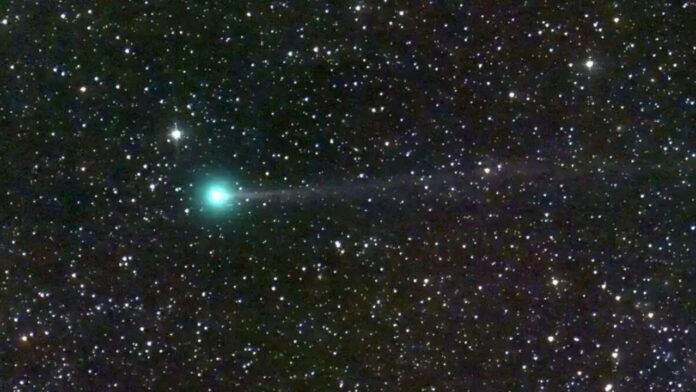A newly discovered comet will pass close to Earth next week, making it visible at times. However, spotting it will require considerable skill.
According to EarthSky, Japanese space photographer Hideo Nishimura first noticed Comet Nishimura in early August while photographing the night sky.
Since then, the celestial object’s brightness has increased as it moves through the inner solar system on its orbit around the sun.
The comet will come within 78 million miles (125 million kilometers) of Earth on Tuesday, which means it could be visible for the next five days.
According to Alan Hale, co-discoverer of Comet Hale-Bopp and founder and president of the Earthrise Institute, it will pass within 21 million miles (almost 34 million kilometers) of the sun on September 17.
Nishimura completes one orbit every 430 to 440 years, “which means the last time it passed close to the Sun (and might have come closer to Earth) was around the year 1590, before the invention of the telescope,” Dr. Paul Chodas of NASA’s Center for Near Earth Object Studies at the Jet Propulsion Laboratory in Pasadena, California, wrote in an email. “We don’t know whether it got bright enough to be seen with (the) naked eye back then.”
There are no comets that appear to coincide with Nishimura during that time period, although it would have had to be fairly bright to be noticed, according to Hale.
What Is the Best Way to Watch Comet Nishimura?
Because the comet is too far away to be seen from Earth and will be travelling close to the horizon, binoculars are the best way to observe it, according to Chodas. And dark sky away from city lights make for excellent viewing.
Sky and Telescope has released charts that can assist skywatchers in locating the comet.
If you’re attempting to tell the comet apart from other objects in the night sky, keep in mind that the comet’s tail will always point away from the sun because sunlight constantly presses on the small dust particles, according to Dave Schleicher, an astronomer at Arizona’s Lowell Observatory. If you want you can also read – Rogue Scientist: NASA Found Life on Mars in 1973 and Killed Them.
While the comet appears greenish in photographs due to the presence of diatomic carbon, it will seem practically colorless or faintly pink through binoculars as sunlight bounces off the dust grains, which are smaller than talcum powder granules, according to Schleicher.
Chodas recommends finding a clear view of the east-northeast horizon approximately half an hour before morning twilight for individuals in the Northern Hemisphere. You can use Time and Date to find out when morning twilight, also known as civil twilight, happens in your region.
“Every day this week, the comet gets closer to the Sun, the time window narrows, and the comet gets closer to the horizon,” he explained. “Unless you’ve seen comets before, this will be a difficult comet to see.”
The comet will be more difficult to view as it gets closer to the sun and the horizon.
The comet will pass between Earth and the sun on Wednesday.
“In theory, it might be visible in the evening sky within a few days after that,” Hale added, “but it will still be quite close to the sun in the sky and buried in bright twilight.” “Unless it becomes significantly brighter than expected, it will most likely be invisible.”
What Will Come Next for Comet Nishimura?
Given how near Comet Nishimura will fly by the sun, the strong heat could destroy it.
“As the frozen ices heat up and sublimate into gases, the comet may break up,” Chodas predicted. “It depends a lot on the size of the nucleus, which we don’t know because it’s surrounded by the ‘coma,’ a gas and dust atmosphere.”
However, considering that the comet has survived at least one previous near contact to the sun, and most likely many more (although the comet’s age is unknown), Hale and other researchers believe it will survive.
“If it survives its passage by the sun, it will pass over to the far side of the sun from Earth in early October, and then emerge into the Southern Hemisphere’s morning sky in November,” Hale explained. “It may be visible for several months after that, though it will most likely be a dim object that fades as it recedes from the sun and Earth.”
The comet will then fly by Earth for over 400 years before it returns.
If you miss seeing Comet Nishimura, Hale predicts that other comets will arrive in the night sky over the next 16 months.
Comet Pons-Brooks will approach closest to the sun in April and should be visible to the naked eye in the evening sky for approximately a month before that, according to the astronomer. Comet Olbers will pass close to the sun in June and can be seen with binoculars. Tsuchinshan-ATLAS, found in January, will travel closest to the sun in late September 2024 and will pass close to Earth in mid-October 2024, with the potential to become quite bright.
Read More: Watch: NASA Shares Video of Pepperoni Storm on Jupiter




![Ranking US States: From Healthiest to Least Healthy [2024 Guide] Health Rankings US States](https://articleify.com/wp-content/uploads/2024/03/Health-Rankings-US-States-218x150.jpg)









![Technical Aspects of 844 Area Code in 2024 [Detail Guide] 844 Area Code](https://articleify.com/wp-content/uploads/2024/01/844-Area-Code-150x150.jpg)














